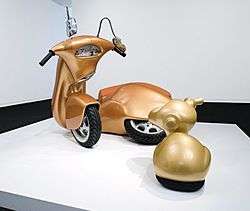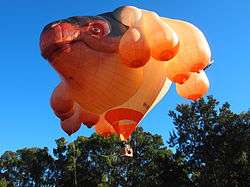Patricia Piccinini
Patricia Piccinini (born 1965 in Freetown, Sierra Leone) is an Australian artist who works in a variety of media, including painting, video, sound, installation, digital prints, and sculpture. Her works focus on "unexpected consequences",[1] conveying concerns surrounding bio-ethics and help visualize future dystopias. In 2003, Piccinini represented Australia at the 50th Venice Biennale with a hyperrealist sculpture of her distinctive anthropomorphic animals. In 2016 The Art Newspaper named Piccinini with her "grotesque-cum-cute, hyper-real genetics fantasies in silicone" the most popular contemporary artist in the world after a show in Rio de Janeiro attracted over 444,000 visitors.[2] Piccinini is currently represented by Hosfelt Gallery in San Francisco, Roslyn Oxley9 Gallery in Syndey and Tolarno Galleries in Melbourne.
Patricia Piccinini | |
|---|---|
| Born | 1965 (age 54–55) Freetown, Sierra Leone |
| Nationality | Australian |
| Education | Telopea Park School |
| Movement | Contemporary art |
| Website | www |

Academia
Piccinini begun studying economics at Australian National University. Later she completed a Bachelor of Fine Arts in Painting at the Victorian College of the Arts in 1991.[3] In 2016 she was awarded an honorary Doctorate of Visual and Performing Arts by the University of Melbourne's Victorian College of the Arts and appointed their Enterprise Professor.
In 2014 she received the Artist Award from the Melbourne Art Foundation's Awards for the Visual Arts.[4]
Works
2000 to 2011
According to her 2002 National Gallery of Victoria biography:
Piccinini has an ambivalent attitude towards technology and she uses her artistic practice as a forum for discussion about how technology impacts upon life. She is keenly interested in how contemporary ideas of nature, the natural and the artificial are changing our society. Specific works have addressed concerns about biotechnology, such as gene therapy and ongoing research to map the human genome... she is also fascinated by the mechanisms of consumer culture."[3]
In 2002, Piccinini presented 'Still Life with Stem Cells',[1] which features a series of flesh-like masses. As she herself says:
"Stems cells are base cellular matter before it is differentiated into specific kinds of cells like skin, liver, bone or brain. Pure unexpressed potential, they contain the possibility for transformation into anything. They are the basic data format of the organic world. Like digital data, their specificity lies in that, while they are intrinsically nothing, they can become anything. They are biomatter for the digital age.
I am interested in how this changes our idea of the body. Already our understanding of the human genome leads us to imagine that we understand the construction of the body at its most intimate level; the stem cell provides us with a generic, plastic material from which we can construct it. In the last ten years, the body has gone from something that is uniquely produced to something that can be reproduced.
This transformation has already occurred, with very little fuss given its magnitude. The question of whether this is a good or a bad thing is both too simplistic and a little academic. As with so much of this biotechnology, the extraordinary has already become the ordinary. The real question is 'what are we going to do with it'. Still life with Stem Cells is one possible answer."[5]
In 2003, Piccinini represented Australia at the 50th Venice Biennale. The work exhibited was 'We Are Family',[6] an exhibition which displayed humanlike mutant figures behaving like humans.
'The Long-Awaited' (2008)[1] was a later work attempting to explore the theme of empathy through a life-like sculpture of a child cradling a manatee-human hybrid.
2012 to 2013

The Skywhale was a work commissioned by the ACT Government for its Centenary year. The ABC described the work as a "hot air balloon in the shape of a tortoise-like animal featuring huge dangling udders made from four hectares of nylon".[7] The budget for the project was $300,000 and has been the subject of comments made by ACT Chief Ministers Jon Stanhope and Andrew Barr.[8][7]
2014 to 2015
.jpg)
In a 2014 interview with the Sydney Morning Herald, Piccinini said of her work, "It's about evolution, nature – how nature is such a wonderful thing, we're just here to witness it, it's not here for us – genetic engineering, changing the body."[9] Following her 2014 win in the Melbourne Art Foundation's Awards, she went on to say that:
The thing about this award on some levels is that my work ... all of it has this first impact, the sort of impact of spectacle. It's beautifully made, strong, aesthetic, so people are interested in that and it draws them in, and then they get interested in the idea. It takes a while to get to the idea. It's not easy. So this award says, "We get it, we get what you're trying to do, we've gone beyond the surface, we can see that there are ideas underneath, and these ideas are about the opportunity for connection".[9]
In 2015 she presented as part of a group exhibition titled Menagerie at the Australian Centre for Contemporary Art, Melbourne.[10]

2016
In 2016, the TAC commissioned Piccinini to work in collaboration with Dr. David Logan, a senior research fellow at the Monash University Accident Research Centre, and trauma surgeon Dr. Christian Kenfield, for "Project Graham" - as part of the TAC's road safety campaign Towards Zero.[11][12] "Graham", a lifelike, interactive sculpture, highlights how vulnerable the human body is to the forces involved in auto accidents.[13] As the TAC explains: "Graham highlights the changes we need to make to protect ourselves from our own mistakes on the road. At the centre of this system is the belief that human health is more important than anything else, he is the embodiment of the Towards Zero vision."[14]
2018
The joint exhibition 'Patricia Piccinini & Joy Hester Through Love ...' at TarraWarra Museum of Art included a new site specific work 'Sanctuary': combining a sculpture of a pair of embracing anthropomorphic bonobo figures of silicone, fiberglass and hair; with a drawing on paper and digital wall print of multiple human limbs forming a horizon.
Responses
Australian art critic John McDonald gives two reasons for disliking Piccinini's body of work: her method of employing artisans to create her designs: "The problem with this method is that the artist's role becomes that of a factory manager."[15] and her engagement with issues such as cross-species relationships: "Given the current state of the planet, in which political leaders are allowing the most blatant forms of racism and ethnic tension to become normalised, Piccinini's interspecies fantasies seem horribly far-fetched."[16]
Screen studies professor and animal ethicist Barbara Creed says Piccinini's work is loving and heals wounds of divisions: "In profound ways, Piccinini's artistic practice calls to the spectator to consider a new way of being, a new form of opening out an embracing difference, through new ways of looking ... that encourages us to look alongside and with her creations while reminding us we are all animals."[17]
See also
| Wikimedia Commons has media related to Patricia Piccinini. |
- Frankenstein argument
- Ron Mueck (similar artist)
- Transhumanism
- Australian art
References
- Smith, Terry (September 2011). "Currents of world-making in contemporary art". World Art. 1 (2): 171–188. doi:10.1080/21500894.2011.602712. ISSN 2150-0894.
- "Top ten contemporary shows in 2016". Retrieved 7 January 2019.
- "Biography: Patricia Piccinini". National Gallery of Victoria. 2002. Archived from the original on 3 April 2008. Retrieved 21 June 2008.
- "Archived copy". Archived from the original on 3 April 2015. Retrieved 8 March 2015.CS1 maint: archived copy as title (link)
- "Still Life With Stem Cells". www.patriciapiccinini.net. Retrieved 26 November 2019.
- "Patricia Piccinini - Artist Profile - Roslyn Oxley9 Gallery". www.roslynoxley9.com.au. Retrieved 7 March 2018.
- "Artist Patricia Piccinini honoured with lifetime achievement award - Books and Arts - ABC Radio National (Australian Broadcasting Corporation)". www.abc.net.au.
- "Skywhale not dead yet: ACT Chief Minister's radio gaffe - ABC News (Australian Broadcasting Corporation)". www.abc.net.au. 6 March 2015.
- Cuthbertson, Debbie (17 July 2014). "Skywhale creator Patricia Piccinini wins national art prize". The Sydney Morning Herald. Retrieved 13 May 2017.
- "Australian Centre for Contemporary Art". www.accaonline.org.au.
- Henry, Lauren; Tribe, Matt (16 September 2016) "Unusual sculpture set to challenge regional Victorians' thinking about road safety", ABC. Retrieved 19 April 2020.
- TAC. "Towards Zero". Road Safety Victoria.
- "TAC latest campaigns". (Victorian) Traffic Accident Commission. Retrieved 26 July 2016.
- "Meet Graham". Traffic Accident Commission.
- "Review Patricia Piccinini Curious Affection". Retrieved 7 January 2019.
- "Review Hyper Real". Retrieved 7 January 2019.
- Barbara Creed, 'Entangled looking : The crisis of the animal', Artlink vol 38, no 1, March 2018, pp8-22.
Further reading
- Gether, Christian (ed.) ... et al. A world of love: Patricia Piccinini. ARKEN Museum of Modern Art, 2019. Content - Foreword / Christian Gether. Embrace the Unknown: Patricia Piccinini and the Aesthetics of Care / Dea Antonsen. Your Place Is My Place / Rosi Braidotti in conversation with Patricia Piccinini. CRISPR and Emergent Forms of Life / Eben Kirksey. ISBN 9788778751317
- Mcdonald, Helen. Patricia Piccinini: nearly beloved. Piper Press, 2012. ISBN 9780975190166
- Messenger, Jane (2011). Patricia Piccinini : once upon a time ... Art Gallery of South Australia. ISBN 9781921668050.
- Queensland Art Gallery. Patricia Piccinini: curious affection. 2019. Content - Arts Minister's message / Leeanne Enoch. Foreword / Chris Saines. Patricia Piccinini : curious affection / Peter McKay. Affirmation and a passion for difference : looking at Piccinini looking at us / Rosi Braidotti. Lines in the sand : a science writer comes to terms with Patricia Piccinini / Elizabeth Finkel. Familiar / China Miéville. ISBN 9781921503894
- McMillan, L. "Mondloch, Kate. A capsule aesthetic: feminist materialisms in new media art."
- External links
- Mondloch, Kate. A capsule aesthetic: feminist materialisms in new media art. Minnesota, 2018. ISBN 9781517900496
- Green, Charles. "Patricia Piccinini: Tolarno Galleries." Artforum International, vol. 55, no. 9, May 2017, p. 356.